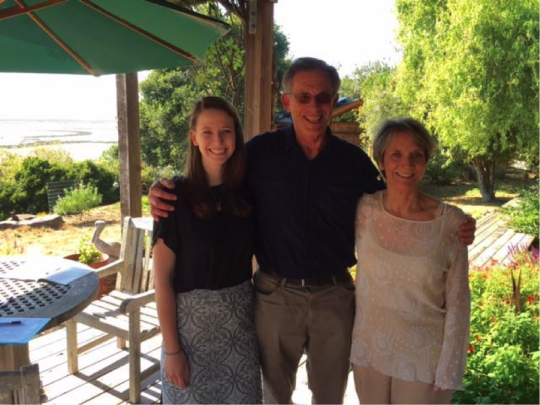by Meghan Demeter | July 28, 2015

[Pictured above: Meghan Demeter, Peter Barnes, Ann Hancock]
I packed up my car five weeks ago and drove down to Santa Rosa from Seattle to start my internship at The Climate Center. I was drawn to the Center as a way to study carbon pricing. As a student of environmental economics, I see this as a necessary step in climate policy, and am interested in the different kinds of systems and how they function.
The Center advocates for cap and dividend as the best method of carbon pricing. A declining cap is placed on carbon emissions, permits for emitting carbon are auctioned to companies, and revenue from auctioning the permits is distributed evenly back to citizens.
Over the past month, I have been working on projects related to cap and dividend, starting with reading the phenomenal With Liberty and Dividends for All by Peter Barnes. Last week, I had the privilege to meet Peter himself, and discuss his book with him.
Peter has pioneered the cap and dividend movement, and remains a wealth of knowledge on its intricacies and the policies and politics surrounding it. While reading his book, I developed a list of questions, to which Peter responded with candor and clarity. Though I already agreed with Peter on many things, I found his responses refreshing and thought-provoking. I imagine I’ll be contemplating his ideas for some time, and hope to be part of making them a reality.
Peter believes that in order to build a movement – as is necessary to see dramatic success in climate protection – we need to create economic benefits for people. This is one of the underlying principles of carbon pricing: by putting a price on something we don’t want, we disincentive its use. But Peter goes further in his advocacy for dividends. If we implement a carbon pricing system in which every person is paid directly, the benefits become more visible and the negative aspects (e.g. higher energy prices) harder to find. By benefitting the average person, we can build a coalition with a broader support, beyond the usual suspects of environmentalists, Democrats.
And that is absolutely necessary. To build support for climate protection – particularly carbon pricing – we must enlist support from people and groups beyond those that already agree with us. Peter summed it up quite nicely when he said that we should be pursuing change in an evolutionary rather than revolutionary way. By finding a solution within our current economic system that provides something for everyone, cap and dividend can help us do just that.
Stay tuned for my next post, which will look into California’s cap and trade system and the “invisible” climate dividend.
–
Meghan Demeter is an intern with The Climate Center. She will be
entering her senior year at Western Washington University,
double-majoring in Environmental Economics and French with a minor in Energy Policy.